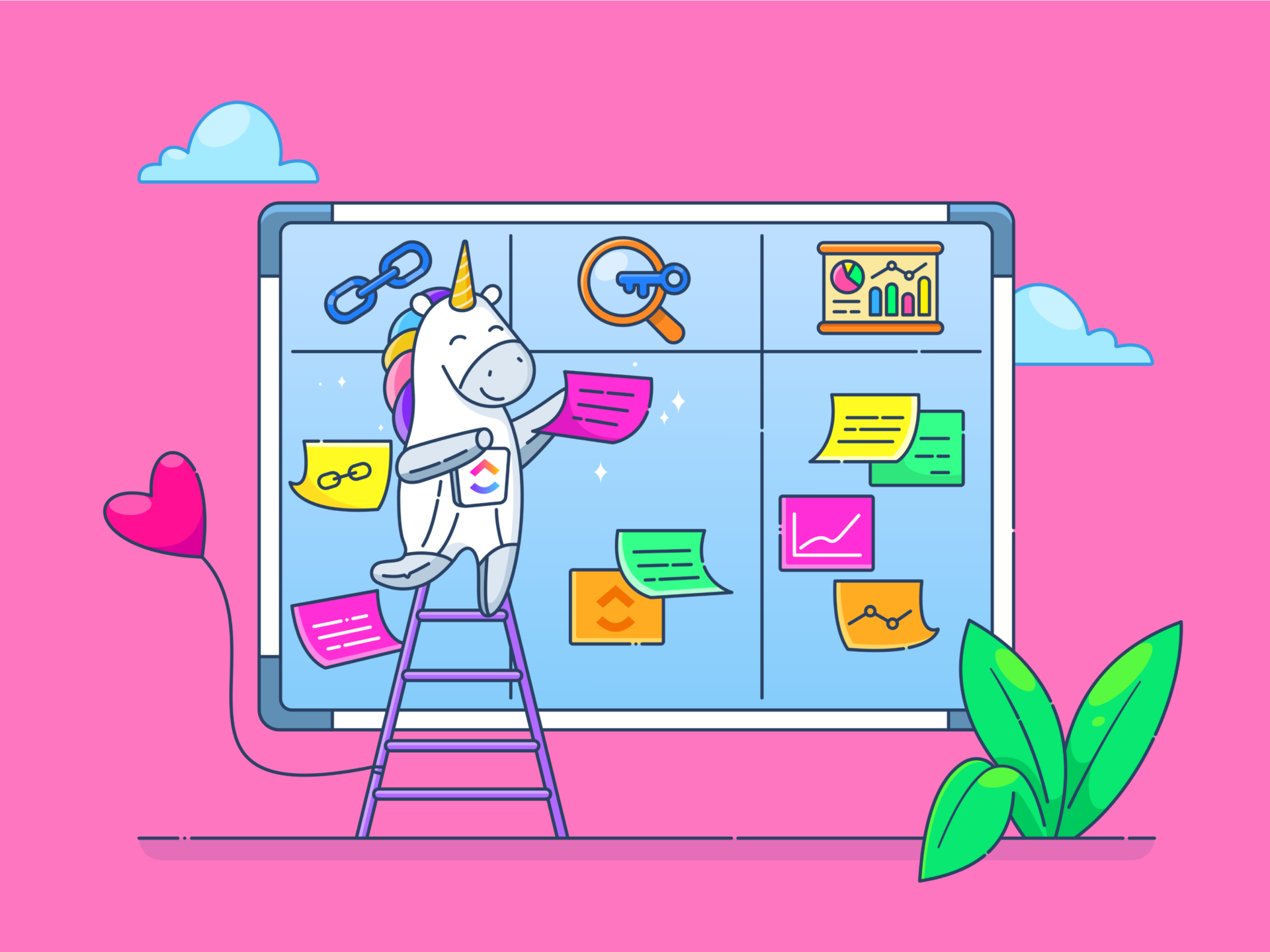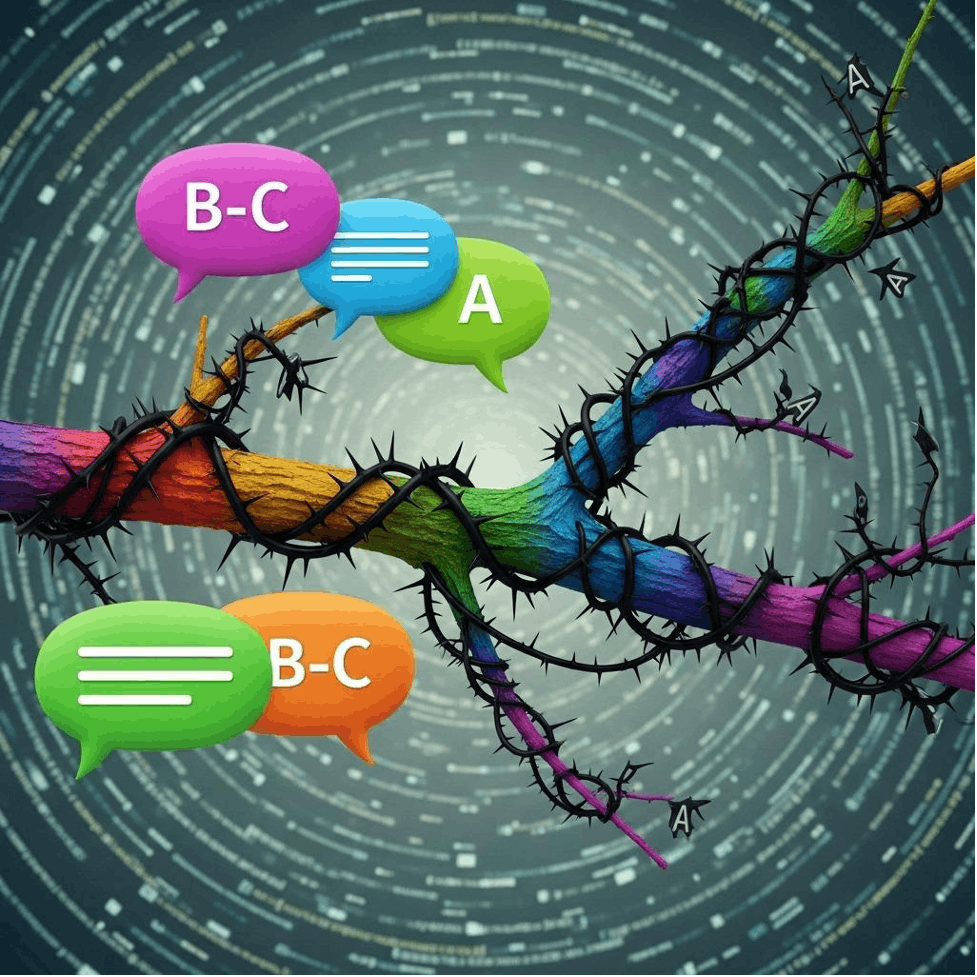Whenever you attend a strategic meeting—whether company-wide or within your team—you’ve likely encountered slides that document Objectives and Key Results (OKRs), and Key Performance Indicators (KPIs).
Businesses rely on them for a good reason—they provide a data-driven, quantitative approach to the performance management process.
But here’s the big question: When should you use OKRs, and when should you use KPIs?
In this blog, we’ll break down their key differences (with real-world examples) and show you how to integrate both into your processes for maximum impact.
OKR vs. KPI: Choose the Right Framework(+Examples)
What Is an OKR?
OKR (Objectives and Key Results) refers to a goal-setting framework used by organizations (and teams) to define goals and measure performance.
Generally speaking, an OKR has three components:
- Objective: A qualitative statement that describes what you want to achieve
- Key results: Quantitative metrics that measure progress toward your objective
- Initiatives: The strategy (specific projects or tasks) that will help achieve the key results
OKRs provide a sense of purpose, direction, and ownership. They push teams to focus on what matters most without being distracted by the tens of low-priority, low-impact tasks on their to-do list.
Some scenarios where OKRs work well are:
- Quarterly planning: They help teams prioritize efforts and focus on the most critical initiatives within a specific quarter
- Strategic initiatives: Using OKRs when launching new projects or initiatives can help you set clear goals, improve transparency between cross-functional teams, and ensure everyone is working toward the same end result
- Performance reviews: They provide measurable data points for performance reviews, enabling more objective and insightful feedback devoid of any personal biases
And now, let’s look at how you can set up and track OKRs:
- Begin with a clear understanding of your organization’s vision and strategic objectives, tying your OKRs to your overarching mission
- Define 2 to 4 ambitious and attainable objectives that reflect what you want to achieve within a specific timeframe (typically quarterly)
- For each objective, set 3 to 5 measurable key results (metrics) that will track progress
- Create an actionable plan so that all team members understand how the OKRs align with individual responsibilities
- Regularly check in on progress toward the key results through weekly or bi-weekly meetings
- Discuss what worked and what didn’t; use these insights to refine future OKRs
Examples of OKRs
Now that we’ve discussed OKRs and when they can benefit your organization, let’s examine some specific OKR examples.
⚒️ Example 1: Project management
- Objective: Improve project delivery efficiency
- Key result 1: Reduce project completion time by 20%
- Key result 2: Achieve a project budget variance of less than 5%
- Key result 3: Increase stakeholder satisfaction score to at least 90%
- Initiative: Use project management software to track tasks, deadlines, and progress in real-time
- Initiative: Create reusable templates for project plans, risk assessments, and communication plans to reduce manual work
🔮 Example 2: Strategic planning
- Objective: Expand market presence in Asia
- Key result 1: Achieve a 15% market share in Asia within one year
- Key result 2: Launch three new products tailored for Asian markets
- Key result 3: Establish partnerships with five local distributors
- Initiative: Launch localized marketing campaigns in key Asian markets with culturally relevant messaging
- Initiative: Analyze competitor pricing and develop a competitive pricing strategy to attract new customers
🎧 Example 3: Customer support performance
- Objective: Improve customer support experience
- Key result 1: Reduce average response time for customer inquiries by 30%
- Key result 2: Increase customer satisfaction ratings from surveys to over 85%
- Key result 3: Resolve at least 90% of support tickets on the first contact
- Initiative: Integrate an AI-powered chatbot into your website to provide instant answers to routine queries
- Initiative: Ensure adequate staffing levels during peak hours and implement a multi-tiered support system to handle different levels of customer inquiries
What Is a KPI?
Key Performance Indicators (KPIs) are standalone, quantifiable metrics that demonstrate how effectively an organization is achieving a particular business objective. KPI examples include revenue, customer churn rate, website traffic, and employee turnover.
There are two types of Key Performance Indicators (KPIs)—leading indicators (predictive metrics) and lagging indicators (reflective metrics).
Leading indicators can help organizations anticipate future performance, while lagging indicators provide insights based on past results (historical data).
You’ll find organizations using KPIs in multiple settings:
- Financial KPIs: Measure financial performance, such as revenue growth or profit margins
- Operational KPIs: Assess operational efficiency, like production costs or cycle times
- Customer KPIs: Evaluate customer satisfaction and engagement, such as Net Promoter Score (NPS) or customer retention rates
- Employee KPIs: Monitor employee engagement and review performance, including turnover rates or employee satisfaction scores
Here’s a quick guide to implementing KPIs:
- Identify objectives: Determine what you want to achieve at the organizational, departmental, or individual level
- Select relevant KPIs: Choose KPIs that align with your objectives and provide actionable insights
- Set targets: Establish clear targets for each KPI to define and measure success
- Collect data: Implement systems for collecting and analyzing data related to your selected KPIs
- Monitor progress: Regularly review KPI performance to assess progress and make necessary adjustments
- Communicate results: Share KPI outcomes with stakeholders to foster transparency and accountability
👀 Did You Know? 80% of your results come from 20% of your efforts. So, focus on a small number of critical KPIs that drive the most significant impact.
KPI examples
📌 Performance appraisal metrics
- Sales revenue: Measures the total deals closed and revenue generated by an employee
- Customer satisfaction: Measures the level of satisfaction customers have with an employee’s service—their CSAT score
- Meeting attendance: Measures the employee’s attendance at meetings and training sessions
📌 Business performance metrics
- Revenue growth: Measures the percentage increase in revenue over a specific period
- Customer churn rate: Measures the rate at which customers stop doing business with a company
- Market share: Measures the percentage of the market that a company serves.
- Return on Investment (ROI): Measures the profitability of an investment
📮 Insight: 78% of our survey respondents struggle with staying motivated on long-term goals. It’s not a lack of drive—it’s how our brains are wired! We need to see the wins to stay motivated. 💪That’s precisely where delivers.
Track achievements with Milestones, get instant progress overviews with rollups, and remain focused with smart Reminders in ; visualizing these small wins builds momentum for the long haul.
💫 Real Results: users report they can handle ~10% more work without the overwhelm.
The Difference between OKRs and KPIs
Now that we’ve seen how OKRs and KPIs can individually benefit your organization and how you can set them up, let’s dive into the nitty-gritty to explore their distinct purposes.
| Aspect | OKRs | KPIs |
| Goal-setting | Ambitious, qualitative objectives with supporting quantitative key results | Specific, measurable, achievable, relevant, and time-bound (SMART) metrics |
| Purpose | Define strategic direction and inspire action | Track progress toward specific objectives |
| Scope | Broad goals | Narrow, specific metrics |
| Time-frame | Typically quarterly | Can be for various time frames—daily, weekly, monthly, and others |
| Flexibility | More flexible and adaptable to changing circumstances, often established for longer periods | Less flexible |
Goal-setting
OKRs emphasize qualitative, ambitious, long-term goals that inspire and challenge the organization. They focus on ‘what’ the organization aims to achieve, such as ‘Increase market share’ or ‘Become the industry leader in customer satisfaction.’
KPIs, on the other hand, focus on SMART metrics and how you can achieve a super-specific objective like ‘increasing website visits by 15% by next month.’
🧠 Fun Fact: Some experts call OKRs ‘KPIs with Soul’ because they add context and purpose to metrics, linking outcomes directly to an organization’s mission.
Purpose
OKRs serve as a powerful tool for defining strategic direction, inspiring action, and aligning teams within the organization. They provide a shared understanding of organizational goals, motivate employees, and foster a culture of accountability.
KPIs are more decision-oriented. Their primary purpose is to track progress, measure performance, and identify areas for improvement within a particular process or aspect of the business, and to support data-driven decision-making.
Scope
OKRs typically provide a high-level framework that guides the overall strategic vision for the organization, team, or project.
👉🏼 For example, an OKR might be ‘Increase market share in the European region’ or ‘Launch a new product that achieves 10,000 downloads within the first quarter.’
KPIs provide detailed insights into specific business areas, such as sales, marketing, revenue, or employee performance. They focus on narrower, more specific metrics that provide a granular view of performance.
👉🏼 For example, for a sales team, the KPIs related to the ‘Increase market share in the European region’ OKR might include ‘Increase sales revenue in Europe by 15%’ or ‘Expand distribution channels in three new European countries.’
Timeframe
OKRs work best when planned for the long term, typically at least a quarter. This timeframe strikes a balance between short-term focus and long-term strategic direction, allowing for regular reviews and adjustments to keep the organization on track and adaptable to change.
KPIs, on the other hand, are more flexible. They simply need a time frame and can be tracked over days, weeks, or even years, like the widely used Annual Recurring Revenue (ARR) metric in most organizations.
👉🏼 For instance, daily website traffic helps monitor short-term trends, while the customer churn rate is usually measured monthly or annually. This flexibility allows businesses to track performance at different levels of detail, gaining insights into both immediate progress and long-term trends.
Flexibility
OKRs are inherently flexible and adaptable to each organization’s unique needs and circumstances. They are grounded in the company’s goals, mission, and vision. This flexibility allows adjustments to reflect changing market conditions, emerging opportunities, and unexpected challenges.
👉🏼 For example, if a competitor launches a disruptive new product, an organization can quickly adjust its OKRs to address the latest threat and maintain its competitive advantage.
On the other hand, KPIs should generally remain consistent over time to ensure meaningful comparisons of performance trends and identify areas for improvement. Frequent changes to KPIs can make it difficult to track progress accurately, identify root causes of performance issues, and demonstrate the impact of improvement initiatives.
OKR vs. KPI vs. KRA
Another framework that’s often confused with OKR and KPI is KRA (Key Result Areas). KRAs are SMART goals that organizations set to track progress and success in various roles. They list the main responsibilities associated with a particular job or role.
To sum it up:
- KRAs define the key areas where an organization needs to excel
- OKRs set ambitious goals within those key areas
- KPIs track progress towards achieving those goals
OKR vs. KPI vs. MBO
Similarly, MBO (Management by Objectives) is a framework often used with KPIs and OKRs to track performance. MBO is a process where managers and individual team members collaboratively set objectives, aligning individual objectives with broader organizational goals.
👉🏼 Let’s say a marketing team aims to increase brand awareness for a new line of eco-friendly athletic wear:
- The OKR would be to become the leading eco-friendly athletic wear brand in the target market
- The KPI would be measuring total website traffic from all sources
- The MBO would be the individual goal for each marketing team member, like increasing traffic by 25% within the next quarter using paid ads
Integrating OKRs and KPIs in Project Management
By making OKRs and KPIs part of your project management system, you can tie each of your individual projects to your main, overarching goal. At the same time, the data collected through KPIs enables data-driven decision-making throughout the project lifecycle.
, the everything app for work, brings all your goal-setting, tracking, and project management needs into one place, making performance monitoring effortless.
📮 Insight: Think your to-do list is working? Think again. Our survey shows that 76% of professionals use their own prioritization system for task management. However, recent research confirms that 65% of workers focus on easy wins over high-value tasks without effective prioritization.
’s Task Priorities transform how you visualize and tackle complex projects, easily highlighting critical tasks. With ’s AI-powered workflows and custom priority flags, you’ll always know what to tackle first.
Let’s look at how you can implement OKRs and KPIs in your project management system.
1. Define project-level OKRs
Start by reviewing your organization’s overall strategic objectives and relevant company-level OKRs. Then, ask yourself how a particular project can contribute to these higher-level goals.
You can also conduct a brainstorming session with your leadership team to gather input on potential project-level OKRs. Remember, the goal is to set ‘ambitious,’ outcome-focused objectives.

Using Docs, you can centralize important documentation around the goal-setting process while Brain—’s proprietary AI—helps you brainstorm ideas and come up with relevant goals to chase. It can also summarize decisions around goals and objectives, keeping everyone aligned.


Simply ask Brain to review your various documents and suggest OKRs connecting your larger goal with a specific project. And voila! You’ll get contextual suggestions that you can further refine using prompts.
Once you’ve decided on your objectives, ask AI to create a proof-ready document explaining your objectives and key results to share with the rest of your team.
2. Identify relevant KPIs
The next step is to choose KPIs that calculate progress towards the Key Results you set for your objectives. This will give you valuable insights into project performance, help you identify areas for improvement, and, eventually, make data-driven decisions to ensure project success.
💡 Pro Tip: Ask yourself: “Does this KPI truly show if we’re moving closer to achieving our objective?” Another tip is to avoid overly complex or difficult-to-measure KPIs. Instead, choose metrics that are easy to understand, track, and interpret.
3. Integrate your OKRs and KPIs with your project management tool
Once you’ve decided on your KPIs and checked the accuracy of their data source, you can include them in your tasks and projects. For example, you can use ’s Custom Task Statuses such as ‘On Track,’ ‘Delayed,’ ‘Off Track,’ and more to monitor your KPIs.
even offers free templates that simplify this process, like the OKRs Template. This super-intuitive planning tool is designed to help teams effectively set, track, and achieve their OKRs.
Here’s what this OKR template includes:
- Planning cadence: This outlines the basic structure and timing for OKR planning, such as quarterly or bi-annual cycles, ensuring consistent and timely goal-setting
- OKR lists: These lists allow teams to break down large goals into specific, measurable objectives and track progress toward each Key Result
The template also has multiple Custom Fields to help you categorize and organize your OKRs. For each task, you can add a tag such as Objective, Key Result, Planning, and Play.
Similarly, you can also bucket tasks into a specific ‘Initiative.’ Even better, a progress bar tracks the completion rate based on the number of action items you check.
Once you’ve created your OKR system, the next step is adding your KPIs. You can do this by adding a few more Custom Fields for your tasks:
- Target Value: Number field to note the KPI’s target value
- Actual Value: Number field to note the current KPI’s actual value
- Difference: Formula field to indicate the difference between the target and actual value
- Progress (%): Another formula field to calculate the percentage of the target value achieved


In , you can use the below codes to set up these formula fields:
- Difference: (field(“Target Value”) – (field(“Actual Value”)
- Progress: CONCATENATE((field(“Actual Value”) / field(“Target Value”)) * 100, “%”)
Of course, you can use the KPI Template by to seamlessly set, monitor, and analyze key performance indicators, ensuring your team stays on track toward business goals. Customize it to fit your industry and gain real-time insights into performance trends.
Here’s what this template can do for you:
- Custom KPI dashboards: Visualize progress with dynamic charts and reports
- Automated tracking: Set targets and monitor performance effortlessly
- Collaboration & alerts: Assign KPI owners and receive real-time updates
💡Pro Tip: Pair your KPI Tracking Template with the SMART Goals Template by to set clear, actionable objectives that align with your key performance indicators, ensuring every goal is specific, measurable, and impactful!
4. Set up dashboards to track progress
Now that you’ve set up your OKRs and KPIs, the next step is to track them. The best way to do this is by using OKR dashboards and KPI progress charts.
These consolidate key metrics and progress updates in a single, easily accessible location so you don’t need to sift through various spreadsheets, reports, and data sources.
In , you have a built-in goal-setting and tracking feature— Goals—that allows you to monitor progress toward your goals in real time using customizable dashboards and progress bars. It also gives you quite a few options to organize your data, including:
- Progress roll-up: To track progress towards Key Results and overall project completion
- Gantt charts: To visualize project timelines and identify potential bottlenecks
- Pie charts: To illustrate the breakdown of project tasks or resource allocation
- Number widgets: To display KPIs such as budget spent, customer satisfaction scores, and task completion rates


These visual reports can help you identify areas of strength and weakness, identify potential risks, and make informed decisions about various aspects of your project, ensuring everything is on track.
5. Review progress periodically
The final step is to schedule regular check-ins (e.g., weekly, bi-weekly) to review progress. During this time, you can analyze the data collected through KPIs to adjust key results, revise timelines, or reallocate resources.
OKR and KPI Best Practices
Finally, here are some best practices for setting and managing OKRs:
- Set objectives that are ambitious yet achievable. They should inspire and motivate employees to reach the desired outcomes, not overwhelm them and eventually burn them out
- Focus on a small number of OKRs (typically 2-4 objectives with 3-5 key results each) to maintain clarity and focus
- Encourage continuous feedback among team members regarding their progress on OKRs. This can help identify obstacles early and allow for collaborative problem-solving
Similarly, when setting KPIs, make sure to:
- Select metrics that have clean and reliable data sources and can be quantified and tracked over time
- Automate KPI tracking so you save time and get accurate results
- Use dashboards and charts to visualize KPI data and identify trends and patterns
Finally, ensure that KPIs support the achievement of OKRs by selecting metrics that directly measure progress toward the key results. This alignment creates the perfect harmony between organizational alignment and accelerated growth.
Set up AI-powered OKR and KPI Systems with
To wrap up, OKRs focus on ‘what’ you want to achieve and ‘why’ it’s important. They provide a framework for ambitious goal-setting and strategic direction.
KPIs focus on ‘how’ you’re progressing towards your objectives. They provide data to track performance measures and identify areas for improvement. Typically, you’ll need a few KPIs related to each Key Result to measure progress and maximize your OKR efforts.
While this can be done manually, automating many of these processes using a project management tool like can significantly increase efficiency and streamline the entire OKR process.
For example, you can trigger task updates based on KPI progress, visualize performance in real time with nifty charts, and leverage Brain for brainstorming and busy work—two tasks that often take the most time. The result: less effort and more impact!
Want to better manage your OKRs and KPIs? Sign up for for free.


Everything you need to stay organized and get work done.















